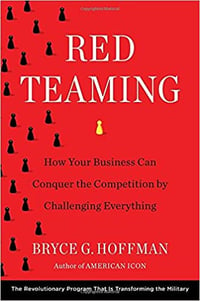 “Hindsight is 20-20!”
“Hindsight is 20-20!”
Most of us can be experts exploring the should and shouldn’t of others.
In Avoid A Blockbuster Failure – Red Team we see Blockbusters’ mistakes, and unlike Former CEO Jim Keyes: Why Blockbuster Really Died and What We Can Learn from It, we can surmise our reasons for Blockbuster’s demise.
To be truly successful in our businesses we need to be able to assess and make better decisions before, not after events or circumstances.
Is there any way to do this and be 100% successful?
There isn’t. :(
Bryce Hoffman, author of Red Teaming: How Your Business Can Conquer the Competition by Challenging Everything can look brilliant after the fact, however there is no miracle prescience.
 We can use tools to help us avoid disasters. A good golfer knows which club to use for the distance and circumstances he faces on a golf course. If we possess the knowledge and experience with resources to help us improve our decision making, we will make better decisions.
We can use tools to help us avoid disasters. A good golfer knows which club to use for the distance and circumstances he faces on a golf course. If we possess the knowledge and experience with resources to help us improve our decision making, we will make better decisions.
As Execution or Bad Choices – Why Do Businesses Fail explains: Most business fail due to poor decisions, not poor execution.
First, one of the exercise Bryce Hoffman believes can help business avoid poor decision-making, then a brief review of two major mistakes Coca Cola and McDonalds made.
Four Ways of Seeing exercise
Please review the images.
Hoffman explains Four Ways of Seeing exercise: “X is your company or organization. Y is the group you are analyzing. It could be your customers, a key competitor, government regulators, a trade union, a supply partner, a retailer, a prospective acquisition, your employees, or even another division within your organization. It can be as general or as specific as your time allows and your plans require. Instead of just looking at your customers as a whole, you could do separate charts for your North American customers, South American customers, European customers, and customers in the Asia-Pacific region. You could do one chart for competitors in general or separate charts for each of your major rivals. It all depends on how much granularity is relevant to the strategy you are developing.
Once you have created your grid, start in the upper left-hand corner of the chart and, working together as a group, think of how your company views itself. Consider your values, your goals, and the characteristics that shape your actions. Are you conservative, or willing to take risks? Do you dominate your industry, or live in fear of 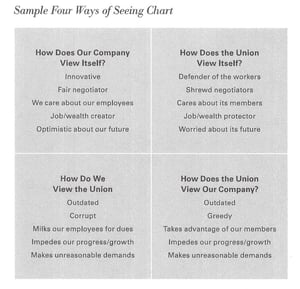 bigger players? Are you proactive, or reactive? Are you innovative, or struggling to keep up with the changing marketplace? Be honest.
bigger players? Are you proactive, or reactive? Are you innovative, or struggling to keep up with the changing marketplace? Be honest.
The point here is not to develop marketing material or write boilerplate for a press release, but rather to make an unflinching assessment of your organization that enables meaningful analysis. Your website may describe your company as “innovative,” but if most employees would disagree with that statement, then leave that off the chart. At the same time, do remember that the question here is not so much about what your organization is, but rather what it believes it is.
As a red teamer, you may recognize that your company is not the most innovative player in its space, but if that is what your organization tells itself and most employees believe it to be true, then by all means write “innovative” in the upper left-hand corner.”
New Coke Failure
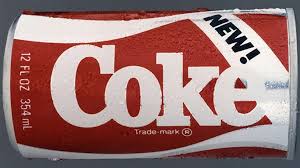 By 1977 “Take the Pepsi Challenge” led to Coke’s own research discovering the same preference for Pepsi’s product. Consumers preferences meant Pepsi passed Coke in food store sales and was undermining Coke’s century-long dominance of the soft drink market.
By 1977 “Take the Pepsi Challenge” led to Coke’s own research discovering the same preference for Pepsi’s product. Consumers preferences meant Pepsi passed Coke in food store sales and was undermining Coke’s century-long dominance of the soft drink market.
Coca-Cola surveyed nearly 200,000 consumers across the United States. Given the choice between “new Coke” and “old Coke,” 61 percent of those surveyed said they preferred the new formula.
After much testing, in April 1985, new Coke launched to stronger than expected sales. Yet quickly complaints and customer protests overwhelmed Coke.
By July 10, just seventy-eight days after the launch of new Coke, Coca-Cola decided to bring back the old formula.
Coca-Cola survived this embarrassment, but it cost the company millions and made it the laughingstock of the beverage industry.
Coca-Cola had asked the right question. It just decided to ignore half the answer.
Coca-Cola asked people if they would be upset if changed its formula. Between 10 percent and 12 percent of Coke drinkers would be upset, but half of them would get over it. Coca-Cola conducted a series of focus groups around the same question. The results were surprisingly different. Once consumers started talking among themselves about the proposed reformulation, some of them started to get really upset. And when they did, many of the other focus group participants started to get upset as well. Coca-Cola executives who observed these groups were stunned by the passion they had unleashed.
One later said, “It was like saying you were going to make the flag prettier.”
With wildly conflicting results, Coke decided to go with the results of the individual surveys and ignore the results from the focus groups.
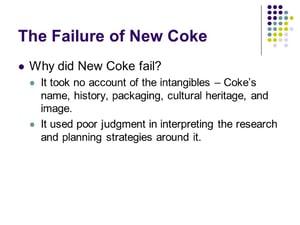 “With the benefit of hindsight, the locus of their research mistake becomes clear. It was to respond to the conflict between the results of the focus groups and the survey of individuals by trusting only the survey. As it turned out, one can see that both procedures had provided important information,” wrote Rutgers University marketing professor Robert M. Schindler in 1992. “When new Coke was first introduced, people made individual decisions on it, and most at least acquiesced to the change….[But] individuals have no means of predicting how their own feelings will change after being exposed to the responses of others.”
“With the benefit of hindsight, the locus of their research mistake becomes clear. It was to respond to the conflict between the results of the focus groups and the survey of individuals by trusting only the survey. As it turned out, one can see that both procedures had provided important information,” wrote Rutgers University marketing professor Robert M. Schindler in 1992. “When new Coke was first introduced, people made individual decisions on it, and most at least acquiesced to the change….[But] individuals have no means of predicting how their own feelings will change after being exposed to the responses of others.”
Schindler concluded that Coca-Cola’s real error was in failing to understand the complicated ways in which social dynamics could influence consumer reaction to its decision to alter an iconic product. It was a complex problem; one any company would have struggled with. It was also precisely the sort of problem that red teaming was created to address.
Use the Four Ways of Seeing to help prevent this response.
That Wasn’t
New Coke, Coca Cola’s attempt to revitalize its brand in April of 1985 lasted just 78 days. Most will cite this as a colossal failure, yet the outcome of this mistake served to strengthen the brand and help it achieve significant brand loyalty for Classic Coke.
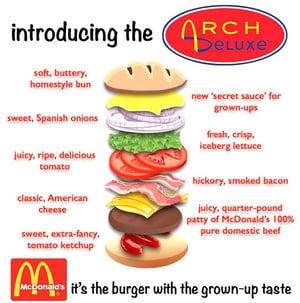 The Arch Deluxe Failure
The Arch Deluxe Failure
In the 1990’s American consumers became increasingly health conscious and more sophisticated to their tastes in food.
Bad news for McDonald’s!
In 1996, McDonald’s announced what the company called its “biggest new-product introduction since the Big Mac”—the Arch Deluxe.
Arch Deluxe was supposed to be “a symphony of tastes,” featuring a stone-ground mustard sauce, peppered bacon, and a potato roll, “The burger with the grown-up taste.”
“The trouble was that nobody goes to McDonald’s for sophistication, they go for convenience. Part of this convenience is knowing exactly what to expect,” explains marketing expert Matt Haig in his book Brand Failures. “Most people who walk into a McDonald’s restaurant know what they are going to order before they reach the counter. They don’t want to be bombarded with a million and one variations on what is essentially the same product—a hamburger.”
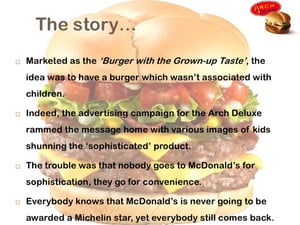 So, how could red teaming have helped McDonald’s avoid this super-size brand blunder?
So, how could red teaming have helped McDonald’s avoid this super-size brand blunder?
Bryce Hoffman explains, “If you were leading a McDonald’s red team when the Arch Deluxe was first conceived back in 1995 and were asked to analyze this new product strategy, you might have started with a Four Ways of Seeing analysis to get a better understanding of how different consumer cohorts viewed the company and its products. That might have revealed the breadth of the chasm McDonald’s would have to bridge to connect with the consumers it was targeting. A Key Assumptions Check would have underscored just how much the Arch Deluxe’s success depended on the company’s ability to close that gap. McDonald’s spent a good deal of time and energy testing its new hamburger with likely consumers, and claimed half of them said they would order another one. That does not sound like a ringing endorsement. But even if it was good enough, the company failed to subject its whole “up-market” strategy to similar testing. Devil’s Advocacy could have exposed just how misguided that plan was, and a Pre-Mortem Analysis could have revealed the consequences its failure would have for McDonald’s brand image and share price.”
Growth demands Strategic Discipline.
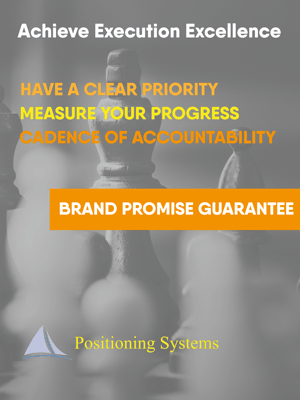 How can you build an enduring great organization?
How can you build an enduring great organization?
You need disciplined people, engaged in disciplined thought, to take disciplined action, to produce superior results, to make a distinctive impact in the world.
Discipline sustains momentum, over a long period of time, to lay the foundations for lasting endurance.
It’s the framework for Good to Great:
- Stage 1: Disciplined People
- Stage 2: Disciplined Thought
- Stage 3: Disciplined Action
- Stage 4: Build Greatness
A winning habit starts with 3 Strategic Disciplines: Priority, Metrics and Meeting Rhythms. Fore
-2.jpg?width=300&name=3%20Disciplines%20of%20Execution%20(Strategic%20Discipline)-2.jpg)
casting, accountability, individual, and team performance improve dramatically.
Meeting Rhythms achieve a
disciplined focus on performance metrics to drive growth.
Positioning Systems helps your business achieve these outcomes on the Four most Important Decisions your business faces:
|
DECISION |
RESULT/OUTCOME |
|
PEOPLE |
|
|
STRATEGY |
|
|
EXECUTION |
|
|
CASH |
|
Positioning Systems helps mid-sized ($5M - $250M) business Scale-UP. We align your business to focus on Your One Thing! Contact dwick@positioningsystems.com to Scale Up your business! Take our Four Decisions Needs Assessment to discover how your business measures against other Scaled Up companies. We’ll contact you.
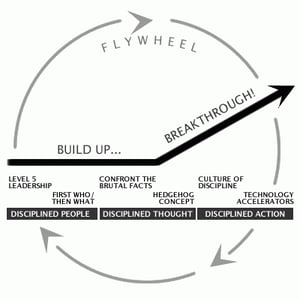 Next Blog – Why and How to Use Your Flywheel
Next Blog – Why and How to Use Your Flywheel
Jim Collins’ Turning the Flywheel: A Monograph to Accompany Good to Great generated a lot of feedback and interest. What’s the value of having your flywheel identified? Why should you discover your Flywheel? One example and the progress a customer is making since he identified his, next blog.






.jpeg?width=150&height=135&name=Hand%20with%20marker%20writing%20the%20question%20Whats%20Next_%20(1).jpeg)

